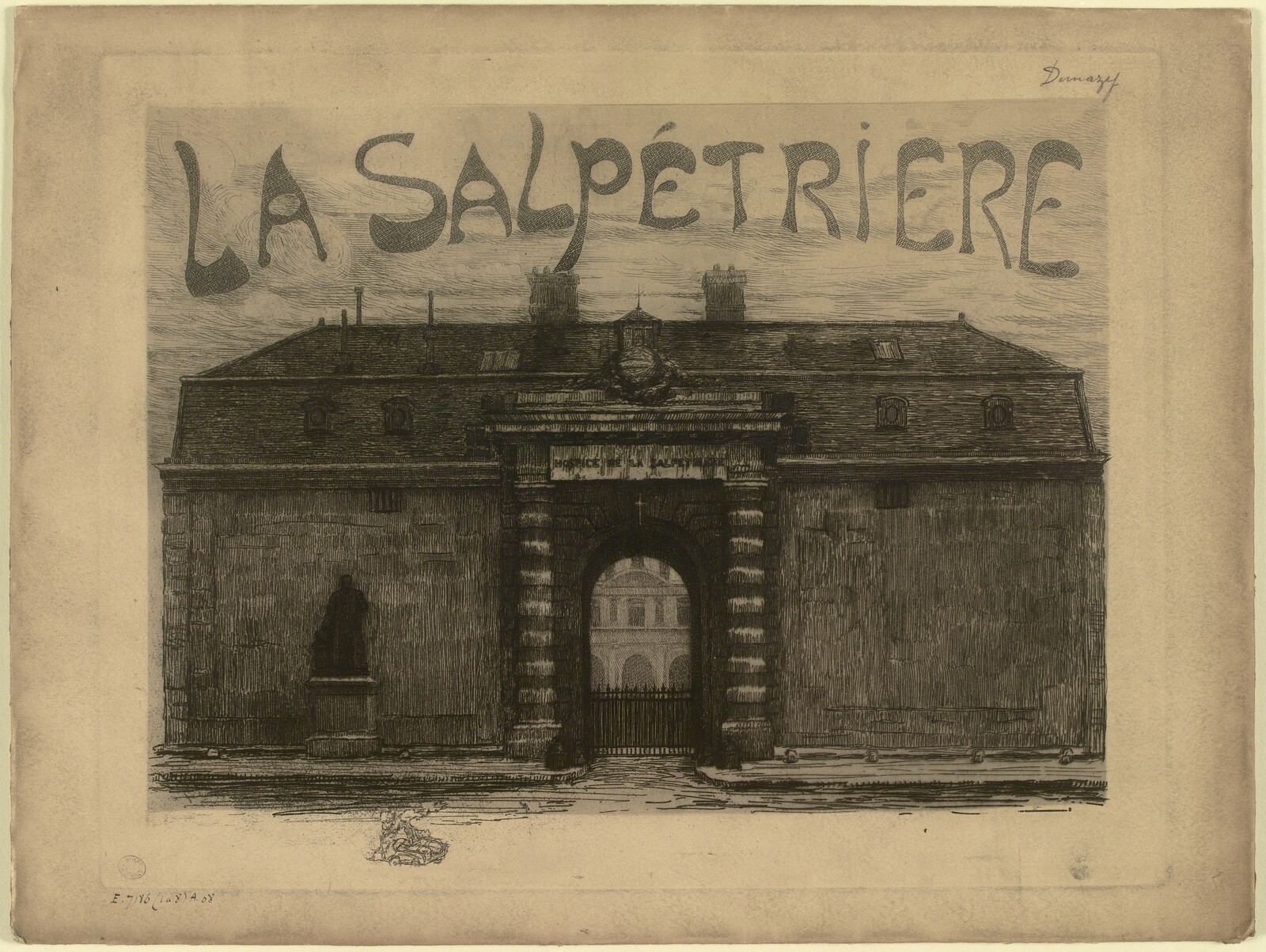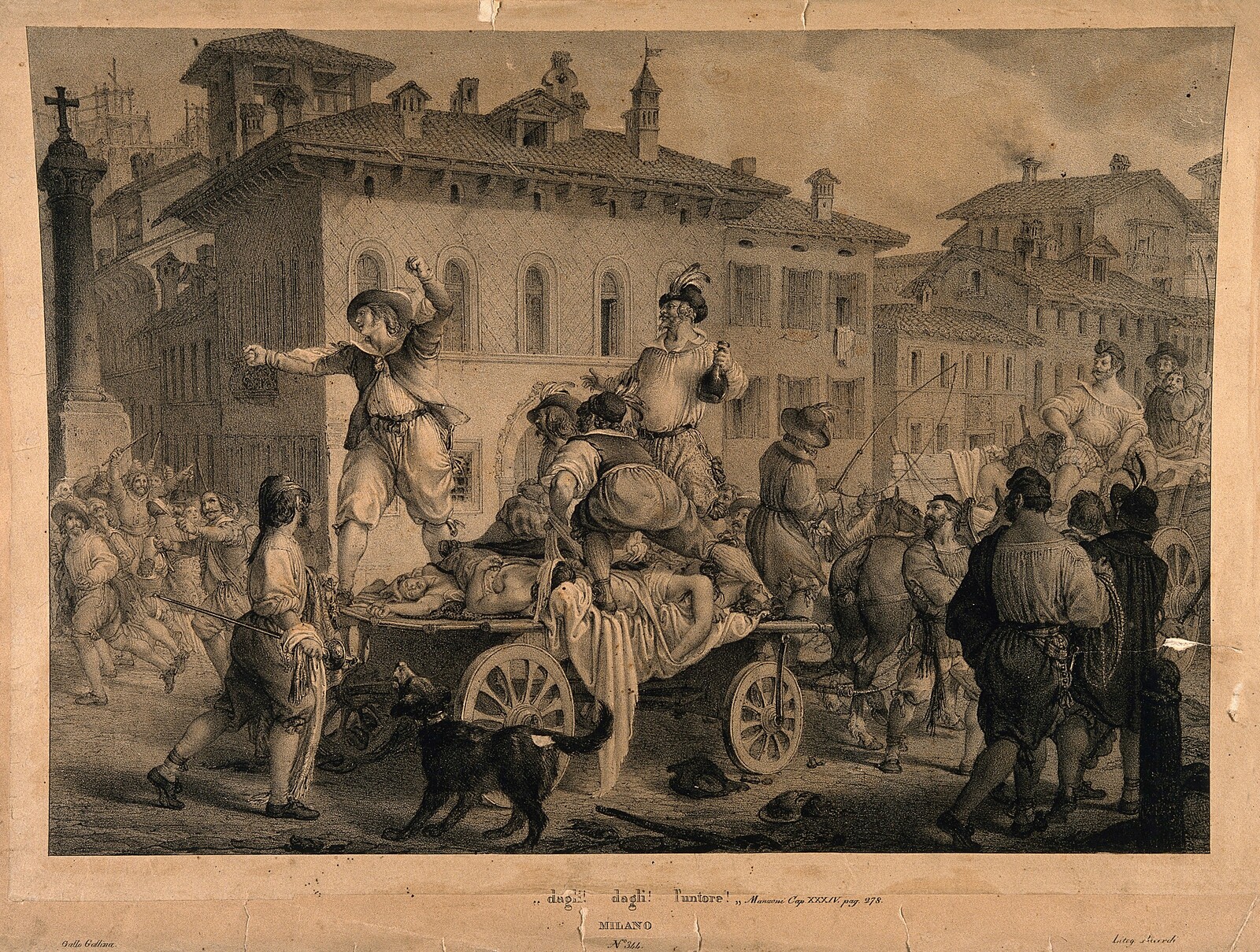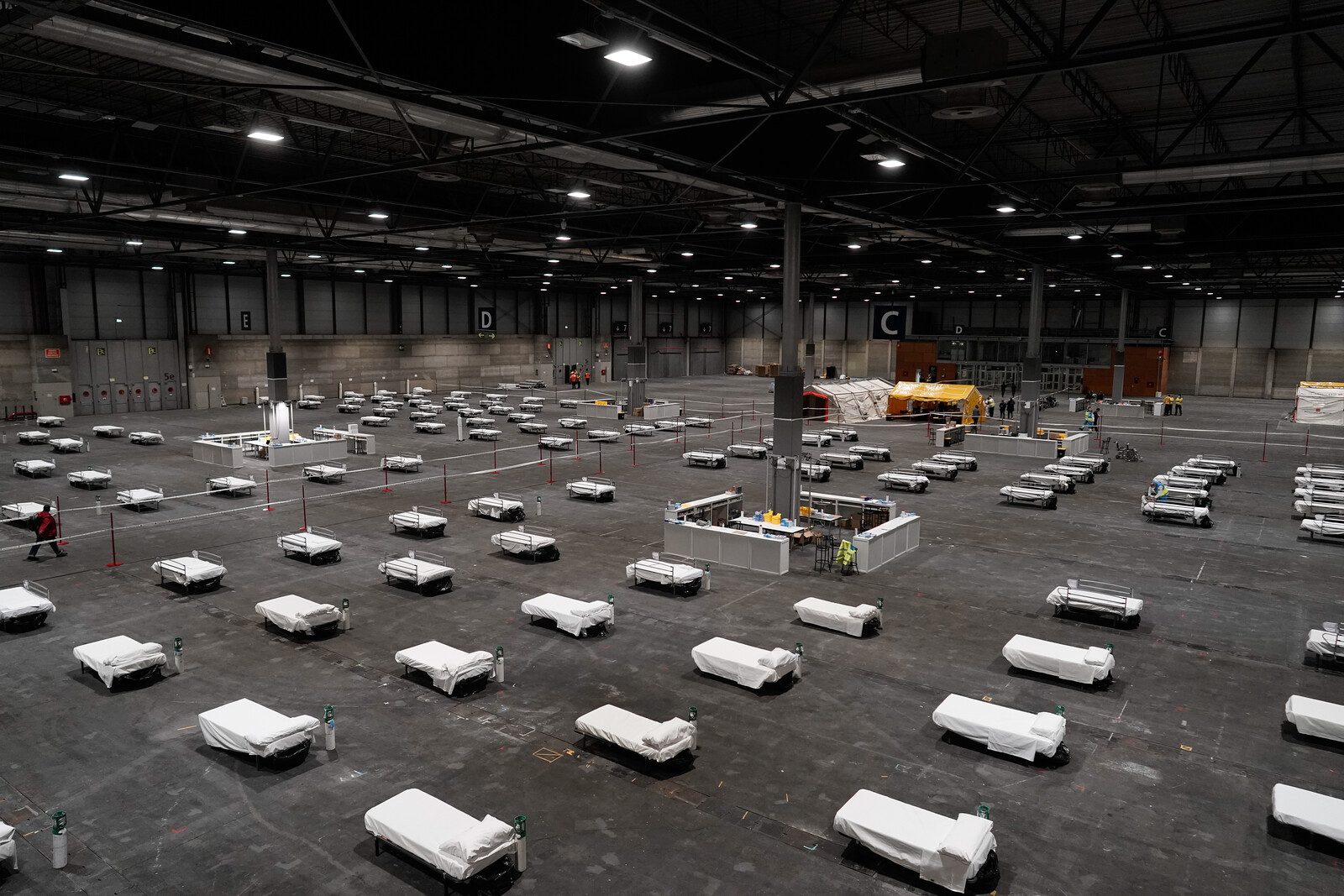For all the scientific discovery and technological progress heralded by late modernity, its lasting legacy is also one of disenchantment and alienation. This alienation was psychological and physical, and was manifested in the bodies of the growing rank of industrial workers. The monotony of factory work and the environmental effects of its production clouded the minds, lungs, and entire being of urban populations. An undercurrent of anxiety towards growing industrialization and urbanization of modern life was exemplified in Georg Simmel’s proclamation that “There is perhaps no psychic phenomenon which is so unconditionally reserved to the city as the blasé outlook.”1 He painted a picture of the mind of the modern, urban citizen that was so overwhelmed by external stimuli to be rendered inert. That static mind translated to a docile body. To a growing movement of doctors, scientists, gymnasts, and performers, this docility had to be corrected, through exercise.
Histories of health and exercise tell stories about human bodies and the ways they’ve been idealized, sculpted, and tortured into different forms. They capture evolving standards of strength, beauty, science, and medicine. As these relationships with our bodies change, so do the spaces and apparatus used to hone them. Yet there is a central theme within the historical development of exercise: its connection to martial and carceral histories. Military barracks and prison yards were often the first testing grounds for bodily improvement—or as it was understood there, for bodily correction and discipline. As exercise moved in the domestic realm, the corrections exercise targeted were not explicitly tied to an innate criminality, but rather sought to address the consequences of a wider societal rot. Its discipline was not martialed on the battlefield, but rather in the character of each citizen as a reflection of a larger national character.
The nineteenth and early twentieth century saw the rise of “body culture” (Körperkultur), an expanding movement that encompassed new trends in exercise and bodybuilding. It made celebrities of strongmen who performed great feats in front of adoring audiences that would go on to read their books and magazines, attend their gymnasiums, and adopt their lifestyle. These exercise spectacles provided a compelling counternarrative to the lassitude wrought by modernization. Bodies could be reclaimed from industrialization, and there was an expanding class of doctors, designers, and performers shaping the methods. It would take control, but also the very same mechanization that engendered both innovation and ennui, in order to do so.
Perfecting the Body Through Gymnastics
Physical education had been an important component of classical education in Germany from as early as the fifteenth century, and the cultivation of a specific exercise practice was primarily the privilege of the aristocracy. Activities like horseback riding, fencing, and dancing were important components of shaping the image of the gentleman. These exercises were not only social signifiers, but also relied on aesthetic judgments like the purity of a jump, or the style and gracefulness of a dance. However, in the late eighteenth century, there was an increasing interest in maximizing the power of the body rather than its artistry. In 1793, the book Gymnastik, written by Johann Christoph Friedrich GutsMuths, a teacher at a Philanthropinum (Enlightenment-inspired German educational institutions) in central Germany, attempted to detach exercise from gentility.2 Instead of foregrounding the aesthetic aspects of exercise, GutsMuths emphasized the body’s performance—as in the ability for specific exercises to improve strength, endurance, or balance. In the exercise regime outlined in Gymnastik the pommel horse was positioned as a training apparatus that could produce a new range of activities. Vaulting and jumping were no longer valued for purity, but instead for their measurability. GutsMuths shifted exercise away from the artistry to the effectiveness of bodily movement in order to elevate exercise to what he saw as a morally ideal masculine practice.3
The site of GutsMuths’s teachings were centered around the university and other institutions of higher education. In 1809, Friedrich Ludwig Jahn built on GutsMuths philosophies, and moved the space of exercise outdoors. He established a sports field in Berlin that made gymnastics a spectator sport, where curious audiences not affiliated with the schools could watch groups of gymnasts performing different exercises. This public performance of gymnastics enticed audiences and helped Jahn’s pupils establish gymnastic clubs and similar sports fields in other cities. These new clubs were rooted in the same culture of masculinity established by GutsMuths, but also included a more nationalist philosophy. In the aftermath of the Prussian army’s defeat by Napoleon in 1806 and the expanding power of the French Empire, there was a growing desire to bolster German heritage. Jahn tied his gymnastics to the cultivation—or recultivation—of a virile primitive man from ancestral Germanic tribes, and encouraged his students to join the military as an opportunity to seek revenge on the French.4 In 1819, the princes that then ruled the various regions of Prussia banned Jahn’s form of gymnastic as they feared its potential to foment subversive activities. While Jahn’s influence lingered, by the 1830s other practitioners of German gymnastics attempted to deemphasize his politics, allowing the sport to expand through the establishment of independent gymnastics clubs. This form of gymnastics was aligned with dietetics, a philosophy that advocated for a holistic perspective of health that encompassed a person’s nutrition, environment, and their daily habits. Advocates for dietetic gymnastics saw exercise as a means to balance the body with the environment.
A particularly strong voice of nineteenth-century middle-class German health and exercise culture, and advocate of dietetics, was Daniel Gottlob Moritz Schreber. After graduating from medical school 1833, he lectured on dietetics at the University of Leipzig and further channeled these interests into founding a local gymnastics club. In his work with youth, he emphasized the importance of exercise as a matter of ethics and hygiene. When his career in academia faltered, he fully committed to professional practice as an orthopedic physician and medical doctor in pediatrics. When an accident ended that line of work, however, he began to write extensively on the benefits and philosophy of gymnastics. In the opening of his book Ärztliche Zimmergymnastik (Medical Indoor Gymnastics), Schreber proclaims that exercise is a way to reconnect with nature in a way that modern science has overlooked in its over-reliance on “so-called medicinal substances.” He continues:
[Home gymnastics] is the most natural method for bringing the constantly rising tide of culture in each rank of society into harmonious cooperation with the physical laws which govern our human organism. It completes and perfects the whole development of the body, preserves it from countless defects and disorders, while laying the necessary foundation for the development of the mind.5
Schreber’s brought his practice in orthopedics together with his promotion of dietetics’ natural remedies to promote normal bodily development.6 He is particularly noted for the creation of orthopedic devices that materialize corrective postures such as the Geradehalter, a device consisting of a back and neck brace secured to the wearer’s forehead and chest to produce upright posture. Some of his devices, like those designed to prevent masturbation, made the moralizing dimension of his work clear. Even after his sudden death in 1861, Schreber’s influence continued to shape German ideas of the importance of access to nature and exercise. For instance, in 1846 a group of educators in Leipzig who were inspired by Schrebers’s writing built his proposal for a playground which included a small garden plot. The popularity of this playground-garden hybrid grew, and the allotment gardens specially leased in cities to give children space to exercise—called Schrebergartens—spread throughout Germany.7
Schreber’s son, Daniel Paul, was raised according to dietetic principles and with orthopedic devices. Born in 1842, Daniel Paul Schreber would become a well-established judge in Leipzig until he suffered a nervous breakdown. The initial onset of his nervous breakdown was attributed to overworking himself. What began as a bout of insomnia quickly spiraled into severe anxiety, paranoia, depression and suicidal thoughts. Daniel Paul describes hearing voices and witnessing “miracles” during his breakdown, and one such memory seems to evoke the chest constricting posture of his father’s Geradehalter.8 Daniel Paul’s experience became an important case study for Sigmund Freud. In Freud’s interpretation, his father, Moritz Schreber, was a looming figure whose orthopedics experiments were directly tied to Daniel Paul’s anxieties.9 Frued’s interpretation of this relationship was instrumental to his understanding of the illness dementia praecox, contemporarily known as schizophrenia.
Degeneration was a recurring theme in Daniel Paul’s Memoirs of My Nervous Illness, which documented his breakdown. Santner connects this to wider sentiments of exhaustion and disillusionment that were prevalent in nineteenth century ideas about medical conditions like hysteria and their relationship to rapid technological advancement.[Ibid.] As Anson Rabinbach notes, the belief that a mass intellectual degeneration was caused by modernity was a common refrain in medical literature in the 1870s, and fatigue and exhaustion were cited as the symptoms of the body’s resistance to industrial labor.10 Fatigue was further pathologized into a range of disorders, but most notably neurasthenia, a nervous exhaustion that nineteenth century physicians tied directly to modernity.11 Yet in 1847, the second law of thermodynamics was discovered, which opened scientists and engineers to conceive of a new relationship between the body and technology as a matter of energy conservation. The human body was recast as a technical object, which could be optimized by replacing human energy with new technologies, or inanimate technical energies.12 Technology could save, rather than destroy human energy. Through a deeper medical and scientific understanding, the body could grow with, rather than against modernity.
Pilates and the Birth of Contrology
Joseph Pilates was born in 1883 into this post-Schreber world in Mönchengladbach, Germany. Although his family was poor, his father was an avid gymnast and took Joseph and his younger brother to the gymnasium as children. His father demonstrated how to use each gymnastic apparatus and hoped that an interest in gymnastics would make Joseph, his frail son, strong. Joseph was also introduced to boxing at the gym, which not only led to a lifelong passion for techniques of boxing and gymnastics, but also a deep intellectual curiosity about the workings of muscles. As his interest in exercise grew, Pilates was particularly drawn to the work of two figures, Eugen Sandow and Bess Mensendeick.
Eugen Sandow was a world renown strongman and celebrity of late-nineteenth-century Körperkultur. Although born and raised in Königsberg, Sandow initially made a name for himself in Britain where he performed feats of strength like breaking an iron chain around his arm simply by flexing his muscles, bending iron rods, and even fighting a lion. Sandow channeled this fame into business—opening his own gyms, publishing a magazine, and writing books. Sandow also created and sold his own exercise machines and apparatuses. Pilates was especially inspired by his book Strength and How to Obtain It, in which Sandow laid out a definition of Körperkultur which stressed training the whole body in order “to get rid of the defects that civilization and the changes it has brought about are responsible for making humans neglect their own body.”13 Sandow further emphasized the rehabilitating power of his exercise methods in a chapter titled “Why Body Culture is the best cure for some diseases,” which advocated for his methods as a cure for “rheumatism, hip pain, pulled muscles, inflamed joints, scoliosis, flat feet, [and] rickets.”14
The work of the American Bess Mensendieck presented gymnastics in a way that emphasized grace and beauty. Her book Die Körperkultur des Weibes (The Body Culture of Women) built on a method of training that was popular with dancers, the Delsarte system, which emphasized breathing and relaxation along with strengthening. Mensendieck was also unique in her method of documenting her exercises. Like the photographs in the book, Mensendieck encouraged her students to do their exercises nude. She believed that nudity allowed the instructor and pupil to see, and therefore better understand the muscles that were being exercised.15
By 1914 Joseph Pilates had been married, widowed, was a father, and felt compelled to follow in the footsteps of his hero Eugen Sandow by trying and make a name for himself in Britain. He arrived in Blackpool, England that summer and proceeded to work a series of odd jobs until the outbreak of World War I. That fall he was arrested with other German citizens and interned as an “enemy alien.”16 Pilates used his time of internment as an opportunity to establish his training practice. He organized activities among his fellow internees and, using his knowledge of boxing, led self-defense courses and group exercises.17 In 1915 Pilates was transferred to the largest internment camp for German civilians in Britain, Knockaloe on the Isle of Man.18 There he continued to develop his exercise method and was inspired local stray cats, which he observed to develop more natural stretching techniques that mirrored their lithe movement. At Knockaloe, Joseph had a captive audience of fellow internees to practice his methods. He particularly worked with sick or injured internees to test his methods as a form of rehabilitation. This, in particular, was crucial to what became his primary inspiration over the years to come: creating apparatuses that could stretch while also developing strength. His recent biography claims that “the camp beds that were provided in the hospital barracks” had springs in them, “as opposed to the wooden bedsteads with straw bags the internees had to sleep on in their barracks.”19
While politically agnostic, Pilates related everything to the body. He thought that the economic and political failures of post-World War I Germany could be resolved by citizens who had a healthier and more thoughtful relationship to their body, and his life after internment would be dedicated to spreading this idea. With the end of the War in 1919, Pilates returned to Germany with proven success of his methods, friendships with German boxers, and a headful of new ideas on how to spread his technique. He remarried, had another child, and moved to Hamburg to open his own boxing gym. Although he never had a winning record, Pilates pursued a career as an amateur boxer. He became better known locally as a respected trainer. As he worked with and competed against other boxers, he started building his first piece of exercise equipment. In 1922 he filed patent number 375001 for “Vorrichtung zur Beseitigung oder Besserung von Bein- und Fussfehlern o.dgl.,” or a “device for removal and improvement of foot and leg dysfunctions,” which relied on elasticity to provide resistance.20
As he juggled his work as boxing trainer and waited for the approval of his first patent, which would eventually come in 1923, Pilates set out to expand the scope of his apparatuses by designing something that could correct and strengthen the entire body. He also began training members of the Hamburg police in self-defense. At the time, police training was based on jiu-jitsu and boxing. Working with the police, then, allowed Pilates to buttress his expertise in boxing with a mastery of basic jiu jitsu skills. This skillset introduced him to methods of resistance training with a partner. His work with the police department also reintroduced him to ideas about nudism he first saw in Bess Mensendieck’s exercises when an officer introduced him to the volkisch movement. While it is unclear what Pilates’ feelings about their latent antisemitism, racism, and fascism were, he strongly supported their belief in the connection between exercise and nature.21 The free naked body in nature provided an idyllic counterimage to the hunched toiling of industrial work.
In 1924, Pilates filed German patent number 427705 for the “Körperübungsgerät,” a full body “physical training device.” Consisting of a small table with a wheeled platform on top of it that could be moved with a system of ropes and pulleys, the apparatus could be “adjusted to different degrees of resistance to accommodate any type of person whether healthy or unwell, large or small.” Similar to his “Foot Corrector,” it also relied on resistance to ensure the user was performing the exercise correctly.22 With the development of this apparatus, Pilates was able to partner with doctors in Hamburg to use it as a rehabilitation apparatus. The large number of soldiers who returned from war with missing limbs had resulted in an expansion of the medical field of orthopedics. Pilates first connected over his fascination with Eugen Sandow with Prof. Dr. Wilhelm Kotzenberg at the University Hospital in Hamburg Eppendorf, who developed a non-surgical arm prosthesis inspired by Sandow’s ability to break a chain by flexing his upper-arm muscles. This shared obsession with strongmen and orthopedic inventions opened Kotzenberg’s roster of clients to Pilates. The results of the full body training apparatus received glowing recommendations from Kotzenberg and clients.23 One of Pilates’s clients, Julius Philipp, raved that he had “legs so crippled I could hardly take three steps with a cane… After Three months of [Pilates’s training method] … I can walk 100 meters without assistance.”24
Once Pilates had proved the efficacy of his training methods, which he now called “Contrology,” and the apparatus that supported it in Hamburg, he sought to expand his influence. He saw America as the perfect place to foster this entrepreneurship and immigrated to New York in 1926. That same year he filed US patent 1621477 for the Körperübungsgerät, which he called the “Reformer,” and opened a studio at 939 Eighth Avenue, between 55th and 56th Street in Manhattan, with help of his wife and business partner Clara, who he met on the journey from Germany. The location of this new studio put him in proximity to the world of dance and performance. Pilates ended up drawing an important part of his clientele from Broadway, a kind of strategic partnership that mirrored his relationship with doctors at the University Hospital in Hamburg. His influence in the world of dance was solidified in 1929 when he successfully rehabilitated Ruth St. Denis, an icon of modern dance, from what she thought would be a career-ending knee injury.
Over the next several years he would invent more apparatus for his growing clientele of dancers, performers, and society people. In 1930 Pilates designed a pair of apparatuses that appeared to fit into a traditional categorization of furniture. His new exercise equipment—a chair and a bed that could also be a couch—adopted the generic language of domestic furniture and could double as such. He filed for US patent 1874613A for the “Chair” that aimed to use his experience with springs to better support a relaxed seated posture. The Chair employed a pivot as a tipping mechanism, so that when a person sat in the chair and leaned back, the back of the chair would adjust to the “body to assume a proper position necessary for complete relaxation and comfort.”25 A similar goal was implemented in his design of a V-shaped piece of furniture that served as either a bed or a couch, US patent 1876743, which he believed conformed better to the body and provided superior resting qualities.26 In 1931, he reconfigured the Chair and filed US patent 1969901A for the design of a more portable, apartment-friendly version that was dubbed the “Wunda Chair.” Instead of functioning like traditional furniture, however, the Wunda Chair was also a device for exercise. It could be oriented on different sides to correspond with various exercises and was light and portable enough to be carried outside for exercise en plein air.27

US patent 1874613 for “Chair,” filed by Joseph Pilates in 1930.

US patent 1874613 for “Chair,” filed by Joseph Pilates in 1930.
US patent 1874613 for “Chair,” filed by Joseph Pilates in 1930.

US patent 1876743 for “Bed or Couch,” filed by Joseph Pilates in 1930.

US patent 1876743 for “Bed or Couch,” filed by Joseph Pilates in 1930.
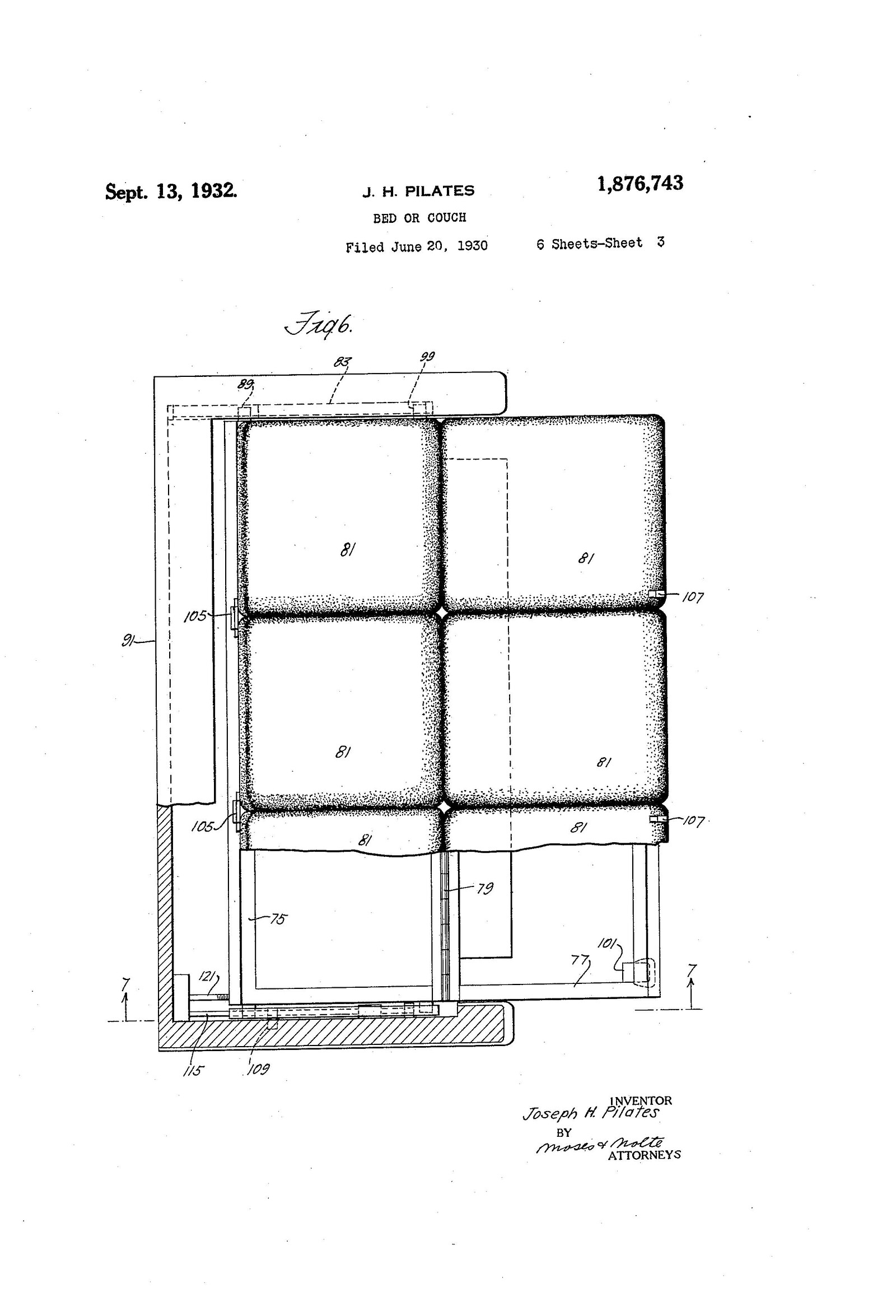
US patent 1876743 for “Bed or Couch,” filed by Joseph Pilates in 1930.

US patent 1876743 for “Bed or Couch,” filed by Joseph Pilates in 1930.

US patent 1876743 for “Bed or Couch,” filed by Joseph Pilates in 1930.

US patent 1876743 for “Bed or Couch,” filed by Joseph Pilates in 1930.
US patent 1876743 for “Bed or Couch,” filed by Joseph Pilates in 1930.
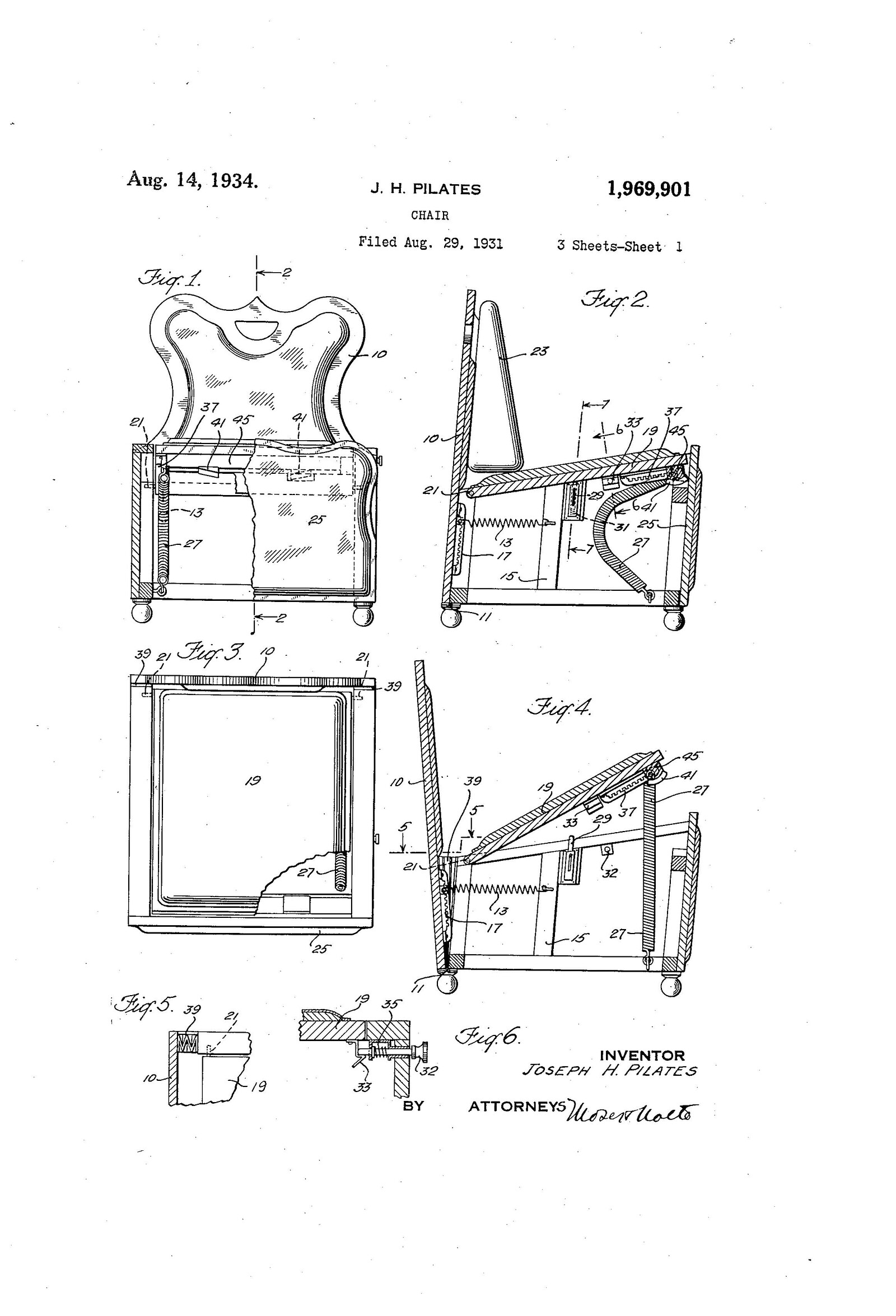
US patent 1969901 for “Chair,” filed by Joseph Pilates in 1931.

US patent 1969901 for “Chair,” filed by Joseph Pilates in 1931.

US patent 1969901 for “Chair,” filed by Joseph Pilates in 1931.
US patent 1969901 for “Chair,” filed by Joseph Pilates in 1931.
In 1955, Pilates had another breakthrough rehabilitation case with the invention of what he called the “Ped-a-Pull” apparatus. Although he didn’t file for a patent for this apparatus due to its similarity with other products, he was particularly proud of its results. The apparatus was made of “two long springs with leather loops at the end, which could either be mounted to a pole with a ground support or directly to the wall.”28 The device was inspired by an apparatus in Eugen Sandow’s London gym for women and attained special significance after the dancer, and Pilates’s longtime friend and client, Eve Gentry underwent a mastectomy to remove a lump in her breast. The surgery removed her entire breast as well as the pectoral muscles crucial for the mobility of her upper body. Gentry was “agitated, desperate, and almost hysterical” at the prospect of losing mobility, but Pilates created exercises with the Ped-a-Pull to strengthen the muscles around the excised pectorals, and after one year Gentry was able to move normally again.29
Inspired by her progress, Joseph, Clara, Eve, and Eve’s husband Bruce Gentry eagerly filmed the training sessions and presented the footage to a group of physicians hoping to get an endorsement and legitimization from doctors at Lenox Hill Hospital. Doctors were dubious of the results at first, so Pilates and team reshot the film, making Eve’s mastectomy more obvious. Yet even after being convinced and impressed by Pilates’s results, they rejected an official partnership because his methods lacked scientific backing.


Eve Gentry training with Joseph Pilates post-mastectomy in 1955.
The unshakeable core of Pilates’ technique was his development of a system of corrective postures and apparatuses to support them. Although the postures generally stayed consistent, with room for adaptation to specific cases, the scope of “correction” was ever expanding. Rehabilitation was central to the development of Contrology, but its definition was malleable. As Pilates’ clientele expanded, he expanded his explanation of the benefits of Contrology. Rehabilitation was no longer just for a specific injury, illness, or disease. Injury, or the deviation of the body from its natural movements, was now a condition of life. The need for rehabilitation was universal. In a 1934 profile in Collier’s magazine, Pilates describes the value of his exercise methods over sports as follows:
Sports are wonderful for the constitution generally, but they are of little value for correcting what’s wrong with you—and there’s something wrong with almost everyone. Corrective exercise is a nasty pill to most people, but it’s the only way to build a beautiful, strong, youthful and one hundred per cent healthy body.30
This diagnosis of a fundamental and universal sickness that required correcting was further elaborated in the 1945 book which summarized Pilates’s life work, Return to Your Life Through Contrology. Before demonstrating his postures in a series of photographs, Pilates and his co-author (and client) William John Miller wrote extensively about Contrology as cure for modernity:
This very rapidly progressing world with its ever-increasing faster tempo of living demands that we be physically fit and alert in order that we may succeed in the unceasing race with keen competition which rewards the “go-getter” but by-passes the “no-getter.” Physical fitness can neither be acquired by wishful thinking nor by outright purchase. However, it can be gained through performing the daily exercises conceived for this purpose by the founder of Contrology whose unique methods accomplish this desirable result by successfully counteracting the harmful inherent conditions associated with modern civilization… Even those of us who work in the city and are fortunate enough to live in the country must counteract the unnatural physical fatigue and mental strain experienced in our daily activities. Telephones, automobiles, and economic pressure all combine to create physical letdown and mental stress so great that today practically no home is entirely free from sufferers of some form of nervous tension.31
Return to Your Life Through Contrology summarizes the appeal of Pilates as a project of both mental and physical health. Pilates’ apparatuses were designed to make the exerciser think more deeply about what her body was doing, and therefore emphasized the use of mechanization as a bridge, rather than split, between human modes of thinking and feeling. Furthermore, Contrology exemplifies the ouroboros-like etiology of modern exercise. Modernity—made evident by expanding industrialization and urbanization—was the illness, but it was also the cure. By harmonizing the body and mind through movement and breathing, Contrology could be a corrective for a world made dizzy by new technologies. At the same time, the body made technical through mechanized furniture that incorporated pulleys and cables into this corrective system of movement returned the body to its productive use and made it more capable of dealing with modern life.
Georg Simmel, “The Metropolis and Mental Life, 1903,” in On Individuality and Social Forms; Selected Writings, The Heritage of Sociology (Chicago: University of Chicago Press, 1971), 329.
Heikki Lempa, Beyond The Gymnasium: Educating the Middle-Class Bodies in Classical Germany (Lanham, MD: Lexington Books, 2007), 73.
Lempa, 76.
Lempa, 80.
Daniel Gottlieb Moritz Schreber, Medical Indoor Gymnastics (London: Williams & Northgate, 1899), vi, ➝.
Schreber, Medical Indoor Gymnastics.
Lempa, 239.
He recounts the horrifying “so-called compression-of-the-chest-miracle, which I endured at least several dozen times; it consisted in the whole chest wall being compressed, so that the state of oppression caused by the lack of breath was transmitted to my whole body.” Giorgina Samira Paiella, “Madness, Modernity, and Mechanization: Daniel Paul Schreber’s Memoirs of My Nervous Illness, the Feminized Industrial Laborer, and the Rise of Automation,” Configurations 28, no. 2 (2020): 264.
In this interpretation of Daniel Paul Scheber’s condition, Moritz Schreber was “demonized as the sadistic paterfamilias whose pedagogic practices and orthopedic devices allegedly produced his son’s psychotic predisposition.” Eric L. Santner, My Own Private Germany Daniel Paul Schreber’s Secret History of Modernity (Princeton: Princeton University Press, 2001), 3.
Anson Rabinbach, The Human Motor: Energy, Fatigue, and the Origins of Modernity (New York: Basic Books, 1990), 38.
One doctor noted that neurasthenia was “even more a malady of civilization augmented in intensity as a result of the progress of the past century” and went on to explain how an increase in intellectual work resulted in an increase in intellectual exhaustion. Rabinbach, 154.
Rabinbach, 2–3.
Eva Rincke, Joseph Pilates: A Biography (Hightstown, NJ: Inner Strength Publishing, 2019), 33.
Rincke, 33.
Rincke, 37.
Rincke, 44.
Rincke, 46.
Rincke, 47.
Rincke, 54–55.
He described the essence of the “Foot Corrector” as “the sliding pressure pad which is being moved by overcoming an elastic counter pressure. The shape of the pressure pad can be measured according to the kind of disease. It can be pressured down by guide rails or something of the kind and it is placed in the middle of a footrest plate.” Rincke, 65–66.
Rincke, 71.
Rincke, 72.
Kotzenberg wrote: “Pilates’ methods are without a doubt excellent for the whole musculature … particularly legs, back, stomach, lower extremities, hip accidents (hence) any sport… Especially advised instead of walking.” Rincke, 74.
Rincke, 75.
Joseph H. Pilates, Chair, United States US1874613A, filed February 3, 1930, and issued August 30, 1932.
Joseph H. Pilates, Bed or couch, United States US1876743A, filed June 20, 1930, and issued September 13, 1932.
Rincke, 151.
Rincke, 151.
Rincke, 108.
Joseph H. Pilates and William John Miller, Return to Life Through Contrology (New York: J.J. Augustin, 1945), 3–4.
Sick Architecture is a collaboration between Beatriz Colomina, e-flux Architecture, CIVA Brussels, and the Princeton University Ph.D. Program in the History and Theory of Architecture, with the support of the Rapid Response David A. Gardner ’69 Magic Grant from the Humanities Council and the Program in Media and Modernity at Princeton University.





















